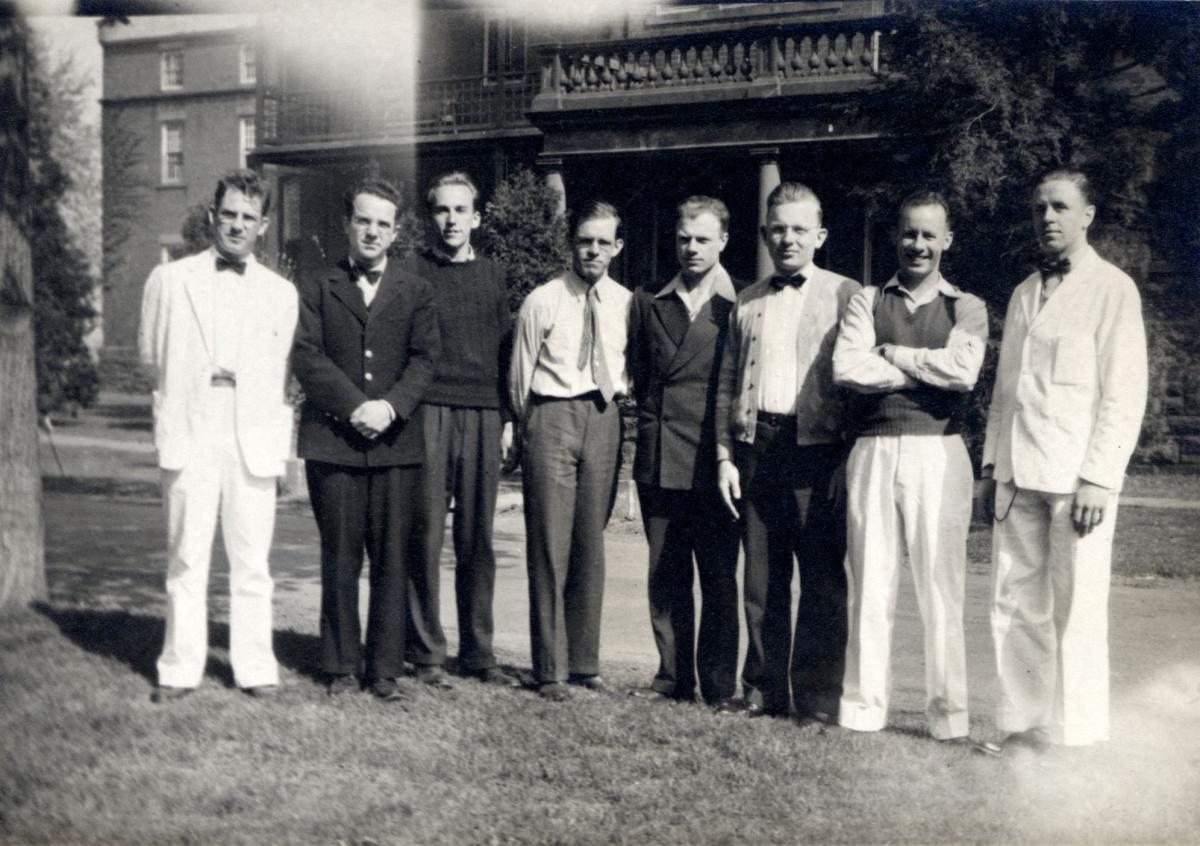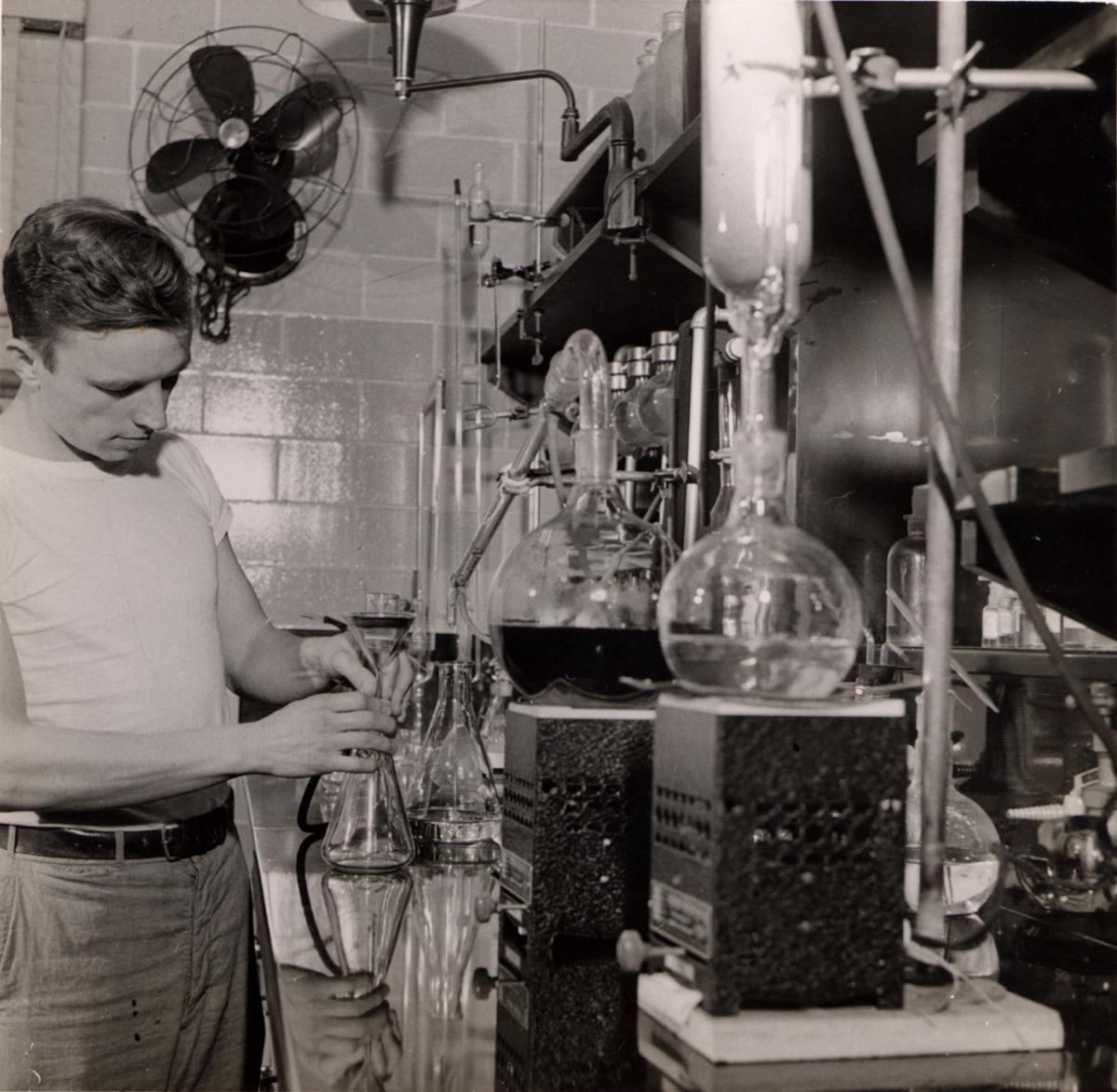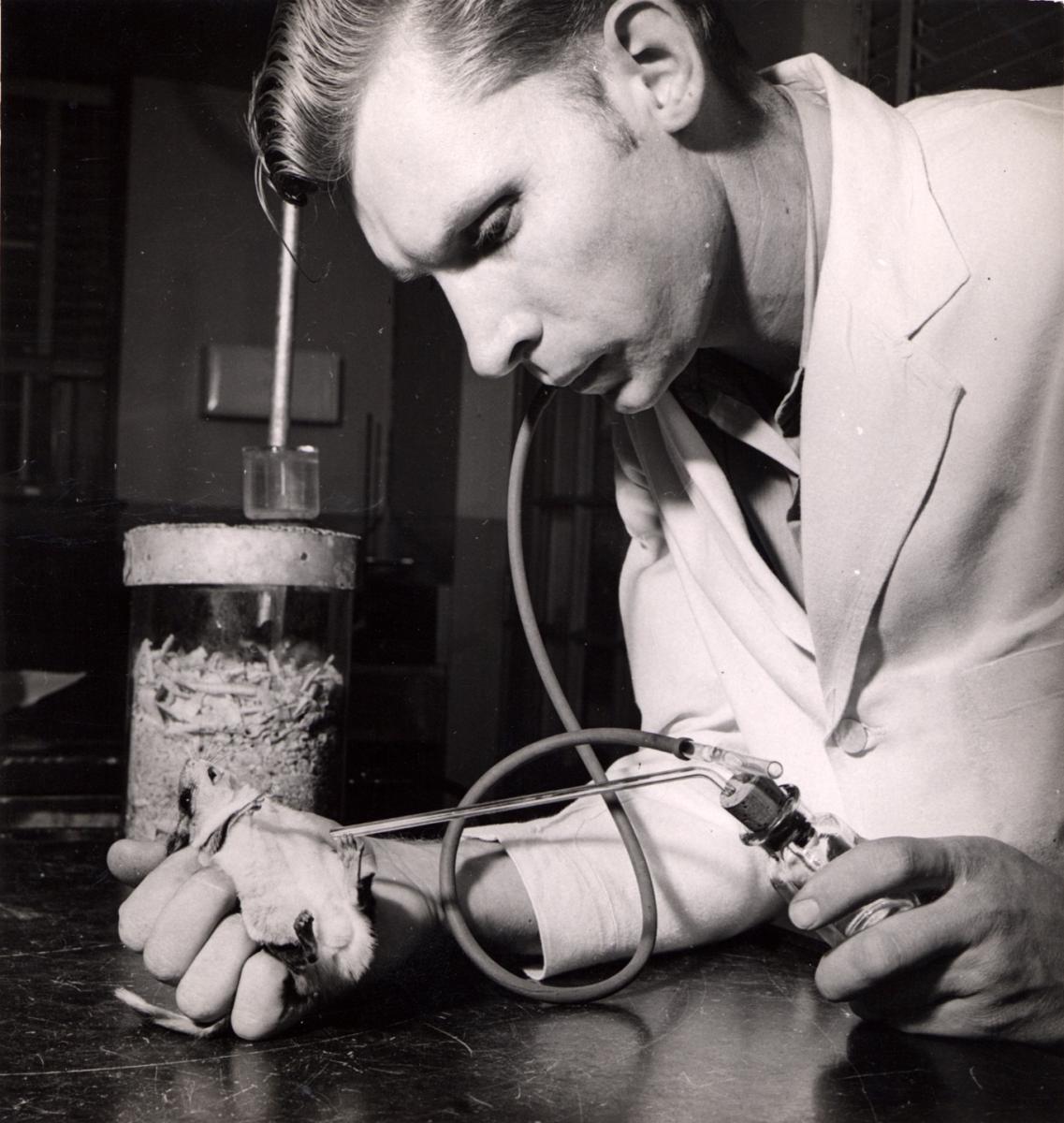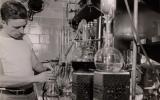CPS Unit Number 081-01
Camp: 81
Unit ID: 1
Title: Connecticut State Hospital
Operating agency: AFSC
Opened: 3 1943
Closed: 9 1946
Workers
Total number of workers who worked in this camp: 108
-
 CPS Camp No. 81, Connecticut State Hospital, Middletown, Connecticut.(l-r) Fred Mathes, Dwight Culler, Owen Hughes, Walter Johns, Charles Gleisner, Clarence Morrison, Joseph Beondo, Herman Hecker.Digital image from the American Friends Service Committee: Civilian Public Service Records (DG 002), Swarthmore College Peace Collection, Swarthmore, Pennsylvania
CPS Camp No. 81, Connecticut State Hospital, Middletown, Connecticut.(l-r) Fred Mathes, Dwight Culler, Owen Hughes, Walter Johns, Charles Gleisner, Clarence Morrison, Joseph Beondo, Herman Hecker.Digital image from the American Friends Service Committee: Civilian Public Service Records (DG 002), Swarthmore College Peace Collection, Swarthmore, Pennsylvania -
 CPS Camp No. 81Man in Science Laboratory. Photo by Wallace Kirkland of LIFE Magazine.Digital image from the Center on Conscience and War Records (DG 025), Swarthmore College Peace Collection, Swarthmore, Pennsylvania
CPS Camp No. 81Man in Science Laboratory. Photo by Wallace Kirkland of LIFE Magazine.Digital image from the Center on Conscience and War Records (DG 025), Swarthmore College Peace Collection, Swarthmore, Pennsylvania -
 CPS Camp No. 81Man in lab coat holding test mouse and test tube. Photo by Wallace Kirkland of LIFE Magazine.Digital image from the Center on Conscience and War Records (DG 025), Swarthmore College Peace Collection, Swarthmore, Pennsylvania
CPS Camp No. 81Man in lab coat holding test mouse and test tube. Photo by Wallace Kirkland of LIFE Magazine.Digital image from the Center on Conscience and War Records (DG 025), Swarthmore College Peace Collection, Swarthmore, Pennsylvania
CPS Unit No. 81, a Mental Hospital unit at Connecticut State Hospital in Middletown, Connecticut operated by the American Friends Service Committee (AFSC), opened in March 1943. AFSC supported the unit until it withdrew from the CPS Program in the spring of 1946. Selective Service then operated the unit until it closed in September 1946. Most of the men served as ward attendants; twenty wives joined the hospital staff as day and night ward attendants.
Connecticut State Hospital was located in Middletown, Connecticut, nearly fifteen miles south of Hartford, and housed three thousand patients. While a hospital of that size would normally employ around eight hundred and fifty people, in 1943 the staff numbered four hundred. The hospital drew patients from the central region of the state, including both Hartford and New Haven.
This American Friends Service Committee (AFSC) unit opened in March 1943. AFSC withdrew from the CPS program in the spring of 1946, after struggling with criticism from COs and war resisters objecting to its cooperation with the Selective Service. The unit was operated by Selective Service until it closed in September 1946.
Directors: Alex Sareyan, Rowland Watts
The first fifteen CPS men transferred to the hospital from CPS Camp No.32 in West Campton, New Hampshire. The unit grew to eighty-five men, about one fourth accompanied by their wives.
With regard to demographics of the CPS men at Middletown, “the make-up was similar to the other seven mental hospital units” operated by the American Friends Service Committee. (Sareyan)
In general, men in Friends operated units reported great diversity in religious affiliation, with Friends in the minority, and including men with no affiliation. The men more frequently entered from urban rather than rural areas.
Men in Friends camps and units, when entering CPS had on average, completed 14.27 years of education, with sixty-eight percent have completed some college, graduated and completed graduate and post graduate education. Forty-three percent entered from professional and technical jobs. (Sibley and Jacob p. 171-72)
One man, after his discharge from CPS, was invited to join the Psychology and Biology faculties at Wesleyan University and in time became a full professor. For many years he served on the Connecticut State Hospital Advisory Board, and in a 1988 survey recalled the following:
In my postwar career as an educator, I found that the work I performed working with the mentally ill as a member of the CPS unit helped me understand much about teaching the “normal” student. . . . Our presence at the hospital during the war helped bring about an increased involvement in that institution’s affairs by the community.
Following our departure when the unit was disbanded, a Mayor’s Task Force was established to lobby for better pay and housing for the hospital’s employees. The local Friends’ Meeting arranged for students at Wesleyan to volunteer for weekend service at the hospital. Students were given an opportunity to work on the wards and to attend lectures given by the staff on a various aspects of mental disorders. . . .(in Sareyan p. 260)
Men served as ward attendants providing custodial care. They kept order in the wards, assisted violent patients in restraints with meals, conducted oversight of those patients who performed housecleaning work, tried to keep patients occupied in some meaningful activity, folded laundry and distributed it to the individual patients’ lockers, prepared patients for visitors, assisted patients in preparing for weekly showers, intervened in fights, among other such duties.
Because of severe staff shortage, the hospital had suspended services:
- occupational therapy for all but a few patients
- regular exercise activity outside the ward for patients
- hydrotherapy
Prior to ward assignment within thirty days after admission to the hospital, the hospital provided special services such as electroshock therapy, but once in the wards, the patients received little personal attention. After the CPS unit arrived, staff resumed some occupational therapy and some exercise routines.
Superintendent Dr. Roy Leak recognized and took advantage of the particular skills COs brought to the unit. As an example, musicians introduced music appreciation as a daily part of the program.
The Assistant Director, Alex Sareyan, who came to the hospital with public relations experience, after some service as a ward attendant, began a public relations department for the hospital. The department explained mental illness to the public, as well as promoted harmony and open lines of communication among the administration, employees and patients.
Sareyan regularly visited editors of all the major newspapers in the hospital’s region to pave the way for feature stories on various aspects of the hospital’s life and concerns. The Hartford Courant and The New Haven Register from time to time ran features written in the hospital public relations office. One feature in December 1943 reported that nearly half of the three thousand patients had no visits from family or friends during the year, and asked the community to help remember these “forgotten people” . . .”who might once have been their friends and neighbors”, when making their Christmas list. (Sareyan p. 112)
The department produced two half-hour radio dramas, one featuring post partum depression. Jack Neher, one of the COs in the unit had worked in the NBC studios before his induction and helped develop the scripts. The two worked with a professor at the Yale Drama School nearby. She recruited student volunteers for the project. The program director at radio station WELI in New Haven granted use of the studio to produce both dramas. (Sareyan pp. 115-16)
Approximately twenty wives of the men joined the hospital staff as day and night ward attendants. Unit leadership not only valued the women’s work on the wards but also noted “women’s positive contribution” to morale.
Regular attendants in mental hospitals in this period worked a minimum of fifty-four hours to as many as eighty hours per week, and were paid as little as two to three dollars per day, including room and board. As at other hospitals, some of the regular attendants did not accept the COs, even though the patients did so.
Superintendent Leak maintained open communication with the AFSC Assistant Director of the unit. In fact, he arranged for the assistant director to conduct his administrative duties in a conference room adjacent to Leak’s office. The two interacted daily and CPS concerns could be communicated almost immediately.
Sareyan, utilizing his journalism experience, in May 1943 initiated The Scribe, the house organ for the hospital with a circulation of nearly one thousand copies. One of the patients suggested the name in a hospital wide competition. Appearing once a month, The Scribe included messages and greetings from Superintendent Leak to both employees and patients, features of interest to both groups, as well as comments and letters from readers.
Within six months, employees served on a ten-person editorial board. As the workload increased, other CPS men in the unit assumed editorial responsibilities. The Scribe continued to publish long after the unit concluded its service in September 1946.
Alex Sareyan’s department also published a paper called Communique in 1943.
The Swarthmore Peace Collection CPS archives hold copies of Epistle, a camp paper that changed its name to News of the Unit on October 14, 1944.
Found in the same archival collection, From Middletown, was published from April through September 1945. News and Opinions appeared from December 1944 through June 1945.
For more information on women COs see Rachel Waltner Goossen, Women Against the Good War: Conscientious Objection and Gender on the American Home Front, 1941-47. Chapel Hill, NC: The University of North Carolina Press, 1997.
For more in depth treatment of this unit, see pp. 95-117 in Alex Sareyan, The Turning Point: How Persons of Conscience Brought About Major Change in the Care of America’s Mentally Ill. Scottdale, PA: Herald Press, 1994.
For an in depth history of conscientious objection in the United States, see Mulford Q. Sibley and Philip E. Jacob, Conscription of Conscience: The American State and the Conscientious Objector, 1940-1947. Ithaca, NY: Cornell University Press, 1952.
Swarthmore College Peace Collection, Archival Materials
For more in depth treatment of the mental health and training school units, see Steven J. Taylor, Acts of Conscience: World War II, Mental Institutions, and Religious Objectors. Syracuse, NY: Syracuse University Press, 2009.


